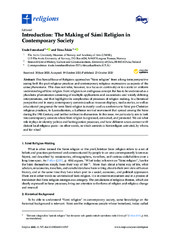| dc.description.abstract | This Special Issue of Religions approaches “Sámi religion” from a long-term perspective seeing both the past religious practices and contemporary religious expressions as aspects of the same phenomena. This does not refer, however, to a focus on continuity or to a static or uniform understanding of Sámi religion. Sámi religion is an ambiguous concept that has to be understood as a pluralistic phenomenon consisting of multiple applications and associations and widely differing interpretations, and that highlights the complexities of processes of religion-making. In a historical perspective and in many contemporary contexts (such as museum displays, media stories, as well as educational programs) the term Sámi religion is mostly used as a reference to Sámi pre-Christian religious practices, to Laestadianism, a Lutheran revival movement that spread among the Sámi during the 19th Century, and last but not least to shamanism. In this issue, we particularly aim to look into contemporary contexts where Sámi religion is expressed, consumed, and promoted. We ask what role it plays in identity politics and heritagization processes, and how different actors connect with distant local religious pasts—in other words, in which contexts is Sámi religion activated, by whom, and for what? | en_US |


 English
English norsk
norsk